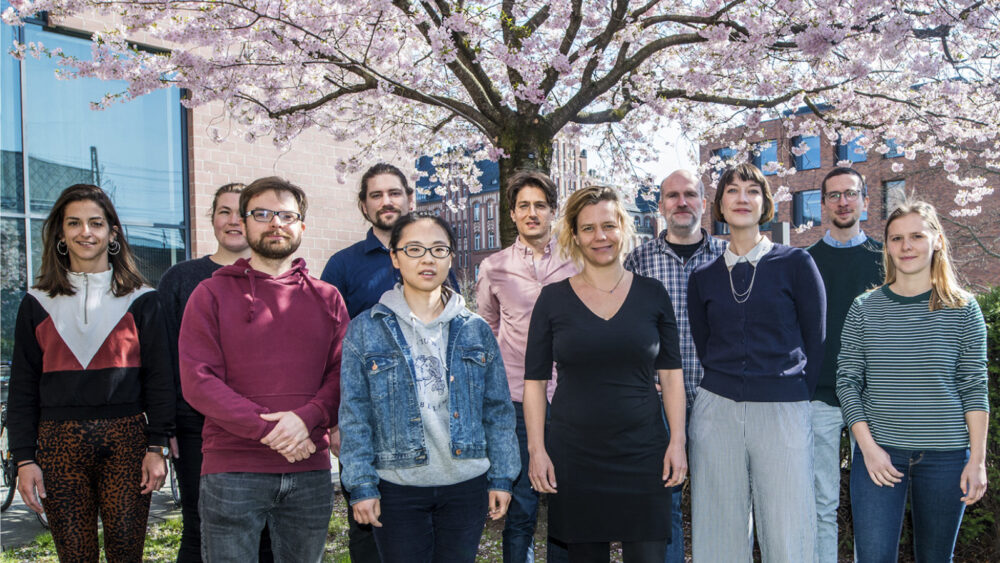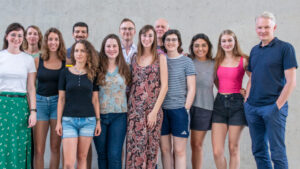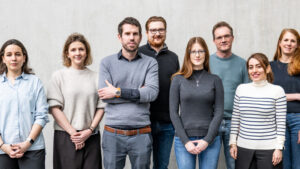

Hauser lab
We aim to understand the dynamic interactions of immune cells in the tissue context
Immune Dynamics
If the immune system reacts to a stimulus, a dynamic interplay of different cells is triggered. Circulating and tissue-resident immune cells, as well as tissue-specific non-hematopoietic cells initiate, maintain, coordinate and terminate an immune reaction. In order to develop novel therapeutic strategies, it is necessary to understand these dynamic cellular interactions on a molecular level.
Long-lived plasma cells produce antibodies and are important players of immunological memory. They protect the body from recurrent infections. In the course of certain autoimmune diseases, however, long-lived plasma cells can produce autoantibodies which are detrimental.
The survival of long-lived plasma cells depends on extrinsic signals. It is therefore necessary to analyse their composition in the spatial context of the surrounding tissue. We have developed a novel microscopy technology, which allows us to follow the dynamic processes in these niches deep in the bone marrow over extended time periods. We could show that the blood vessels surrounding the plasma cell niches are highly dynamic and change their localisation relative to plasma cells. We are now investigating to what extent these changes affect plasma cells and the composition of the niches. We are also using multiplexed histological analyses, which allows us to stain up to 80 markers on one single tissue section, in order to decipher the code of the plasma cell niches.
Plasma cells can also be found in high numbers in the gut mucosa, where they produce massive amounts of IgA. We could show that a fraction of those plasma cells can become long-lived. Niches for long-lived IgA+ plasma cells derived from mucosal immune responses are present within the intestinal lamina propria, but also within the bone marrow. We are investigating whether gut-derived plasma cells include autoreactive cells.
In addition to the physiological sites described above, plasma cells can survive in a number of other tissues under conditions of chronic inflammation. We could show that long-lived plasma cells can persist even in the central nervous system, a tissue void of immune cells in healthy individuals. Consequently, we are now investigating whether antibodies produced by those intracerebral plasma cells contribute to neuronal damage, for example in multiple sclerosis (MS).
Keywords
Multiphoton microscopy
Plasma cells
Confocal microscopy
Hhistocytometry
Chronic inflammation

Group leader
Univ. Prof. Dr. med. vet. Anja Hauser
Ph.D. students
Luise Asmussen
Yu Cao
Johanna Ehl
Henrike Germar
Sandy Kroh
Alina Liebheit
Till Mertens
Raphael Raspe
Technicians
Pendar Alirezazadeh
Robert Günther
Ralf Uecker
- Z. Cseresnyes, Applied Systems Biology, HKI Jena, Germany
- K.D. Fischer, Institute for Biochemistry and Cell Biology; Health Campus Immunology, Infectiology and Inflammation, Otto-von-Guericke University Magdeburg, 39120, Magdeburg
- R. A. Manz, Universität zu Lübeck, Institut für systemische Entzündungsforschung (ISEF), Ratzeburger Allee 160, 23562 Lübeck
- Kai-Michael Toellner, Institute of Immunology and Immunotherapy, Medical School/IBR, University of Birmingham, Birmingham, UK
- H. Radbruch, Institut für Neuropathologie, Charité – Universitätsmedizin, Charitéplatz 1, 10117 Berlin
- C. Wählby, Department of Information Technology, Centre for Image Analysis, Uppsala University, Uppsala, Sweden
- Holzwarth, K., R. Kohler, L. Philipsen, K. Tokoyoda, V. Ladyhina, C. Wahlby, R. A. Niesner, and A. E. Hauser. 2018. Multiplexed fluorescence microscopy reveals heterogeneity among stromal cells in mouse bone marrow sections. Cytometry A 93: 876-888.
- Lindquist RL, Bayat-Sarmadi J, Leben R, Niesner R, Hauser AE. 2018. NAD(P)H Oxidase Activity in the Small Intestine Is Predominantly Found in Enterocytes, Not Professional Phagocytes. Int J Mol Sci 19.
- Reismann, D., J. Stefanowski, R. Guenther, A. Rakhymzhan, R. Matthys, R. Nützi, S. Zehentmeier, K. Schmidt-Bleek, G. Petkau, H.D. Chang, S. Naundorf, Y. Winter, F. Melchers, Duda, G., A. E. Hauser* and R. Niesner*. 2017. Longitudinal intravital imaging of the femoral bone marrow reveals plasticity within marrow vasculature. Nature Commun 8: 2153 * equal contribution
- Pollok, K., R. Mothes, C. Ulbricht, A. Liebheit, J. D. Gerken, S. Uhlmann, F. Paul, R. Niesner, H. Radbruch, and A. E. Hauser. 2017. The chronically inflamed central nervous system provides niches for long-lived plasma cells. Acta Neuropathol Commun 5: 88.
- Radbruch, H., R. Mothes, D. Bremer, S. Seifert, J. Pohlan, L. Ostendorf, R. Guenther, R. Leben, W. Stenzel, R. Niesner, and A. E. Hauser. 2017. Analyzing NADPH-oxidase activation in aging and vascular amyloid pathology. Frontiers Immunol. 8:844
| Title | Running Time / Budget | Funding Body | Reference Number /
Title |
| Analysis of B cell dynamics in chronic neuroinflammation | 2017-2021
(second funding period) 433.440,00 Euro
2013-2017 (first funding period) 453.867,00 Euro |
DFG | CRC130
B cells-immunity and autoimmunity; project 17 |
| Longitudinal Multi-Photon Microscopy and Microendoscopy: Quantifying and controlling Communication and Function of B Lymphocytes in vivo | 2017-2021
700.000,00 Euro |
DFG | CRC130
B cells-immunity and autoimmunity; project C01 |
| Analyzing the Heterogeneity of Innate Lymphoid Cells
and the Relationship with their Microenvironments in situ and in vivo |
2017-2020
412.950,00 Euro |
DFG | SPP1937
Innate lymphoid cells (HA5354/8-1) |
| Longitudinal intravital imaging of dynamics of osteo-immunological interactions during bone healing | 2015-2018
170.000,00 Euro |
DFG | FOR2165 Regeneration in Aged Individuals: Using bone healing as a model system to characterize regeneration under compromised conditions;
project 7 (HA5354/6-1) |
| Junior Group Neuroimmunology, Cluster of Excellence
Neurocure |
2013-2017
657.862,16 Euro |
DFG | EXC257
NeuroCure |

 Deutsch
Deutsch
